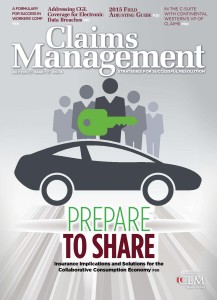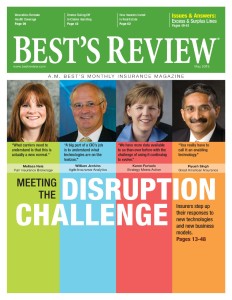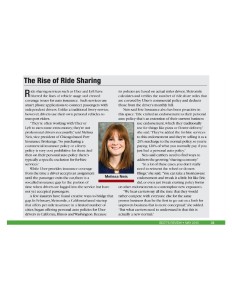By Melissa Neis
Vice President
Parr Insurance Brokerage, Chicago
The sharing economy continues to grow at a rapid rate with thousands of companies and organizations in all parts of the world participating in this popular concept. From sharing houses and cars to equipment and skills, the collaborative consumption model is transforming many industries.
The potential for high profile losses has necessitated the shared sector to pursue better risk management, but frankly and unfortunately, the insurance industry has been slow to respond.
One such high profile loss occurred not too long ago when a San Francisco woman rented her place via Airbnb, the online home-rental marketplace, and returned to find nearly all of her personal possession stolen or destroyed. At the time, Airbnb did not insure against losses.
More recently, a lawsuit against Uber and an UberX driver who struck and killed a 6-year-old girl on New Year’s Eve, also in San Francisco, has shed light on the insurance gaps that drivers of these services currently face.
Peer-to-peer sharing companies depend on the user’s ability to trust that there are adequate risk management procedures in place to cover any damage or loss associated with the transaction. As a result, the insurance industry must create new solutions that provide adequate protection for these new types of business models.
Sharing Economy Surging
The online peer-to-peer model began with eBay in 1995, and this pioneering company influenced many of the share firms that followed. Craigslist, the classified ads website, joined in the late 1990s followed by the car sharing service Zipcar in 2000.
Today, it’s been well documented how the sharing economy is experiencing explosive growth. Uber, the company that specializes in ridesharing, recently was valued at more than $40 billion, more than twice its valuation just six months ago. Various reports place Airbnb’s value at $13 billion, up from $10 billion in 2014.
There are numerous reasons for the phenomenal growth. As a result of the recent economic downturn, many people find it cost-effective to share or rent. In this case, cost and accessibility trump ownership.
Another reason: Folks transforming themselves into part-time entrepreneurs to make extra money. This new economy is ideal for part-time workers, the unemployed, and people who seek a career change.
Advances in technology also have played a significant role in the sharing surge. Smartphone apps allow people to conduct transactions anywhere with the convenience of their mobile phone. Concurrently, online payment services are safe, widely available, feature lower transaction costs and offer quick compensation.
Finally, some people consider the sharing economy as a more sustainable way of living in a world with finite resources.
The rapid growth of the sharing economy offers opportunities and challenges for a variety of industries, but the insurance industry is somewhat behind the curve.
Insurance Industry Response
Insurance as a whole is based on risk modeling and actuarial science and sharing services are a new, disruptive model. Therefore, many insurers have taken a slow and cautious approach. Others have struggled to develop solutions for this new dynamic of consumption and ownership.
Current insurance options available for this new economy often feature high rates and are cost prohibitive for new start-ups. These rates will likely decrease as more risk modeling information is available and with more shared services history to draw from.
Other complications arise if the transaction is international in nature, like with a house swap. For these scenarios, what law applies? Also, what exclusions or limitations are involved with each policy? And what happens if one party to the transaction does not have enough coverage or if there are gaps or overlaps?
Traditional Insurance Products Not Designed for Shared Space
A typical homeowners insurance policy, or ISO HO3, is designed to cover the home, personal property, and liability of the named insured only. In short, an HO3 covers you, your resident relatives and any other person younger than 21 who is under the custody of the person named.
The homeowners policy is specifically designed based on one’s risk profile, not the risk profiles of guests and renters, and are not designed to provide protection for rental or vacation property. In limited cases, homeowners policies may offer some coverage to others, but it’s up to circumstances, underwriters discretion and facts that may arise from deposition.
For people renting or swapping a property over a certain numbers days, an insurer may require the purchase of a landlord or rental home insurance policy known as an ISO Dwelling Fire/DF3. This is not an ideal option either.
A DF3 generally provides coverage for only the building and not its contents or other structures that might be affected. Additionally, the DF3 does not include a schedule or sub limits for jewelry, electronics, securities and other valuables.
A final drawback is the cost of a DF3 plan as they are often more than twice as expensive as a traditional plan.
Insurance gaps with traditional automobile policies are prevalent in the car sharing and ridesharing spaces, too. Those who rent a stranger’s car via services such as RelayRides are typically not covered by their auto plan as most plans exclude vehicle rental for a fee.
For on-demand ridesharing services, the main issue is a possible gap in coverage between the driver’s personal automobile insurance policy and the ride sharing company’s policy. Most drivers’ personal auto insurance excludes liability arising out of the ownership or operation of a vehicle while it is being used as a public or livery conveyance. Some policies go even further and list exclusions for when the driver is available for hire.
Personal policies also may not provide coverage during the period when a driver has activated the ridesharing app but is not carrying a passenger.
Ridesharing drivers seeking a more comprehensive insurance option can purchase a commercial livery policy. However, this plan costs between three and 10 times more than a personal policy and essentially doesn’t make financial sense.
Traditional home and auto insurance policies usually fall short of providing the protection needed in the sharing economy. It’s imperative that users of shared services not assume they are fully covered by their plan and research other insurance options if necessary.
New Insurance Developments
Some companies have responded to the insurance gap by offering limited coverage to all of their users.
For example, to alleviate customer concerns, Airbnb now offers a host guarantee that provides $1 million in damages for all hosts. This $1 million figure has since been adopted by Dofvacay, Lyft, RelayRides, Uber and Feastly for their respective customers.
On the negative side, a blanket option is expensive and cost prohibitive for start-ups in the sharing sector.
Other insurers have developed additional policies or excess policies in the event that personal policies do not pay. Additional policies shift the expense to the consumer. They can be crafted specifically for business, but generic ones exist that offer limited benefits.
Another option is endorsements. Policy endorsements are new to the marketplace and these personal auto policies are designed to fill insurance gaps.
One trendsetter in this field is Erie Insurance. The company recently introduced auto insurance coverage to protect drivers who use ridesharing services like Uber and Lyft in two Midwestern states, Illinois and Indiana.
The Erie policy adds a “business use” designation to eliminate confusion over what’s covered and when, and offers protection during every part of the trip including before, during and after the hired ride. A drawback, though, is that it costs roughly 20 percent more than the standard auto policy rate.
In California, insurance start-up Metromile now allows ride share drivers purchasing coverage to add a new endorsement to their personal auto policy that provides insurance during the pre-match period when the ride sharing application is open but the driver is not matched with a passenger.
And insurer USAA recently announced the launch of a pilot program in Colorado that provides coverage for TNC drivers from the moment they turn on their mobile apps until they are matched to a passenger.
These are the types of policies and solutions that are sorely needed.
In Conclusion
The sharing economy has great mass appeal and its ability to connect strangers signals a cultural shift toward trust. However, the benefits of this growing consumer preference must still outweigh the risks involved.
Conducting background checks and offering review and rating of sharing service users can help increase this trust. However, accidents still happen, which makes risk management of equal importance.
Insurers must create new solutions, redesign business practices from traditional product development to services designed to meet this new peer-to-peer economy, and enhance the customer experience.
Insurers will gain market share in this evolving and growing space by taking a leadership role and working with both regulators and sharing companies to develop innovative and cost efficient solutions.
# # #
About the author: Melissa Neis is vice president of Chicago-based Parr Insurance Brokerage, an independent insurance agency founded to protect high-net-worth individuals and families nationwide with customized insurance coverage. Parr Insurance has relationships with several national and global carriers developing polices for shared economy coverage. Neis can be reached at 773.489.3001 or melissa@parrinsurancebrokerage.com.






